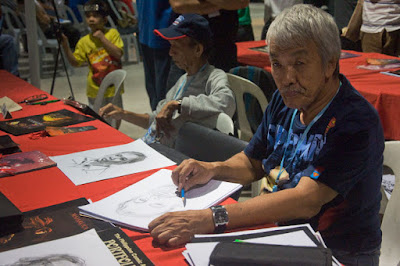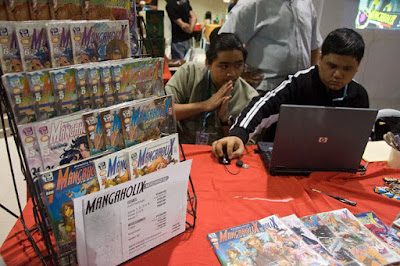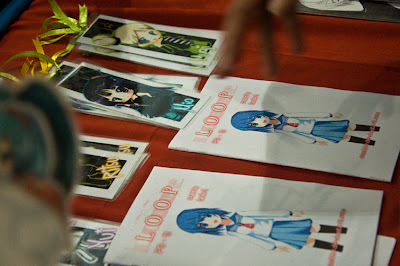In this post I'll survey the komiks industry as mirrored by the event.
Big Fish in a Little Pond
There were a number of heavily promoted releases this year. The most high profile of these was the book launch of the restored and compiled version of colonial-era adventure El Indio by Filipino komiks legend Francisco V. Coching. This restoration was a pet project of Gerry Alanguilan for the last five years, and is now being published by the educational organization Vibal Publishing. The story had to be restored from copies of the serialized pages as the original artwork was completely lost. I'm surprised that such a prestigious work is being published in softcover format. Come to think of it, all the books at the event were released as softcovers.
 |
| El Indio Booth |
The other big release touted by the event organizers was the horror anthology Underpass: Featuring stories written by Alanguilan, Filipino novelist David Hontiveros, and Trese creator Budjette Tan. The book is being published by magazine giant Summit Media, which is why the book is getting a lot more publicity than usual.
Gerry Alanguilan was also releasing two self-published books of his own: The collected edition of ELMER, and a new book Where Bold Stars Go To Die, which is Illustrated by Arlanzandro C. Esmeña. The latter book deals with the brief period of popular skin flicks that were being produced in the Philippines during the eighties. The good news is that ELMER will also be sold at National Bookstore.
 |
| Jun Lofamia and Danny Acuña |
And if Gerry wasn't spread-out thinly enough, he also contributes some art to a much anticipated graphic novel MAJARLICA: Bayan ng Agimat by Rod Rodriguez, Vincent "Jann" Galino and Danny Acuña. The subject matter and art style are a homage to the kind of mythologically-themed komiks stories that were a widely-read staple in the fifties.
I'm probably leaving someone out, but the other major book releases that drew a lot of attention at the con were the third Trese compilation, and 12 by popular comic strip creator Manix Abrera. I gave the first two Trese books a very mixed review, and I will eventually post reviews of these two at some point. As I mentioned, my pile of purchases was bigger this time around.
Manga Rules
While Komikon's most hyped products were softcovers aimed at the bookstore market (Some of them partnered with established publishing houses), the traditional comic book still exists after a fashion. Mango Comics continues to release a number of comics-centered magazines, including the girl-oriented Mango Jam. They've also revived a few classic superhero properties. Gilbert Monsanto's self publishing effort Sacred Mountain Publications focuses on superhero pamphlets: Its most high-profile project is the creator-owned superhero universe title Bayan Knights. Alamat Comics also publishes a number of Western-style titles. But the slickest and most popular periodical is the anthology-style title Mangaholix Presents created by the studio Groundbreakers Inc.
 |
| Mangaholix booth |
While there were a few titles that looked like Western-style alt comics, most of the creators selling minis were clearly influenced by manga. Most of them also have an audience developed through a web presence: Kickbackers, M3 Studios, Camille N, Makurai, daMEAT, Meganon Comics, Silent Sanctum,and lambchild are a random sampling of manga-style artists who have deviantART accounts. They possess differing levels of talent, but their stylistic choices means they all labor in the collective shadow of the world's largest comics industry. Their professional futures aren't all assured. And I get the impression that almost all of them are unfortunately limited to the conventional shonen/shojo axis. But their youth, artistic development through online communities, and their fluency with comic conventions absorbed from a different culture, distinguish them from the more established creators raised on printed matter at Komikon.
 |
| Loop by Camille N. |
